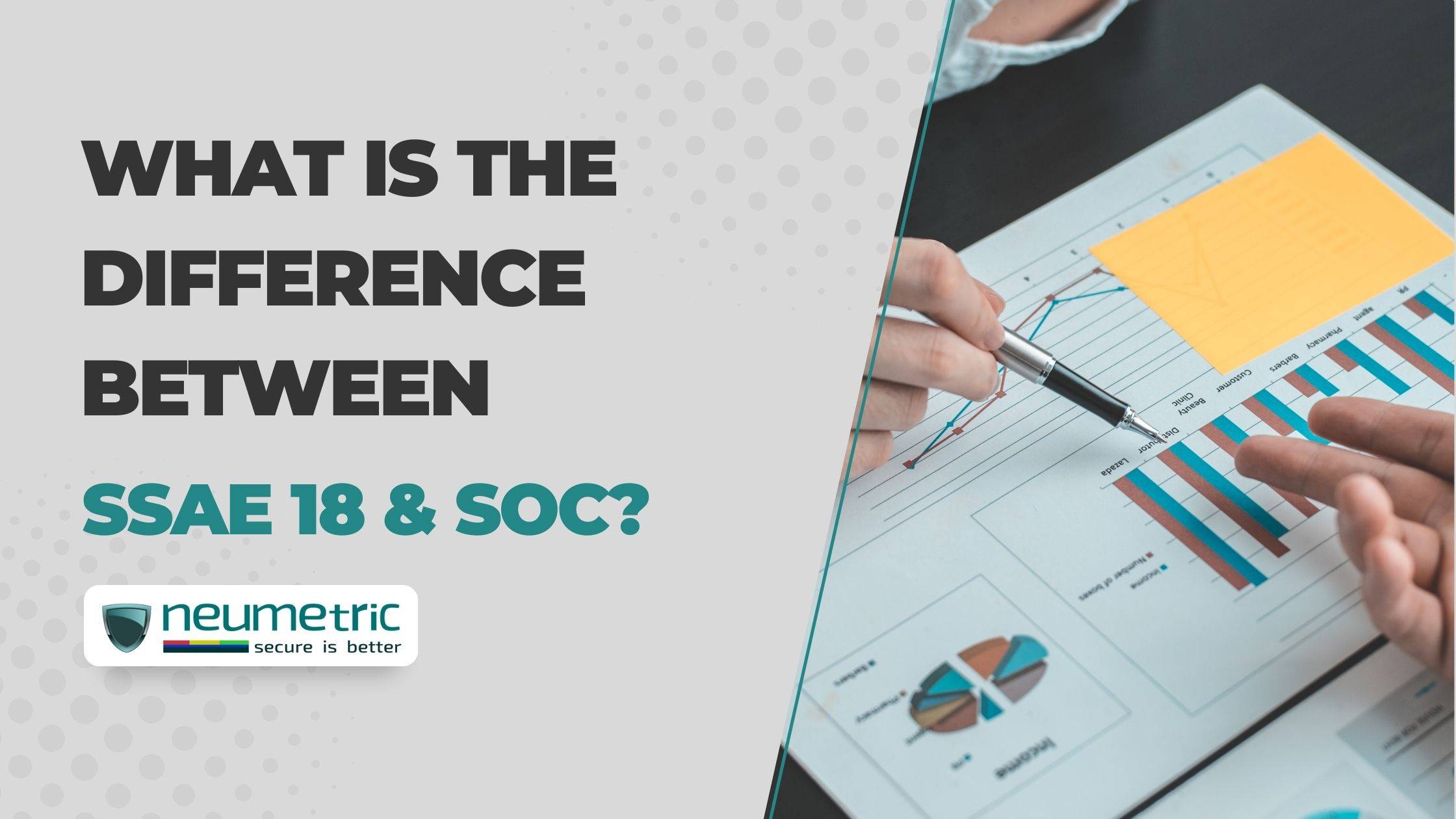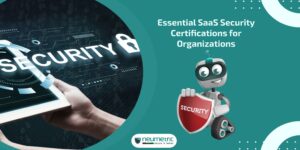Table of Contents
ToggleWhat is the difference between SSAE 18 & SOC?
Introduction
Ensuring the effectiveness & reliability of controls implemented by service organisations is vital for organisations & their stakeholders. Two key frameworks that provide assurance in this regard are Statement on Standards for Attestation Engagements SSAE 18 and SOC Reports.
This Journal explores the differences between SSAE 18 and SOC, covering their unique characteristics, scopes, objectives, compliance requirements, reporting formats, assurance levels & industry relevance. By understanding these distinctions, organisations can make informed decisions on compliance, risk management & selecting the appropriate framework for controls auditing.
Comprehending the disparities between SSAE 18 and SOC is crucial due to their impact on transparency & trust. While both frameworks share the objective of assessing controls at service organisations, they diverge in their focus, intended users & applicability. By gaining a comprehensive understanding of these differences, organisations can navigate compliance complexities & effectively communicate their control environment to stakeholders.
Understanding SSAE 18
Statement on Standards for Attestation Engagements no. 18 [SSAE 18] is a set of professional standards issued by the American Institute of Certified Public Accountants [AICPA]. It provides guidelines for auditors to assess & report on controls at service organisations. The purpose of SSAE 18 is to enhance confidence & provide assurance to users of a service organisation’s controls & processes, including financial statement auditors, regulatory bodies & business partners.
SSAE 18 emphasises the evaluation of internal controls related to financial reporting. Key components include management’s description of the system, the service organisation’s control objectives, the suitability of the design & operating effectiveness of controls & the auditor’s opinion or report.
SSAE 18 compliance is crucial for service organisations that handle sensitive data, financial transactions or provide services that impact their client’s financial reporting. Examples include data centres, payroll processors, cloud service providers & healthcare organisations.
Understanding SOC
Service Organization Control [SOC] Reports are a series of reports developed by the AICPA to assess controls at service organisations. These Reports provide information about the design & operating effectiveness of controls, focusing on various aspects such as financial reporting, security, confidentiality, privacy & availability.
SOC Reports are categorised into three types: SOC 1, SOC 2 & SOC 3.
SOC 1: SOC 1 Reports primarily evaluate controls relevant to financial reporting (previously known as Statement on Auditing Standards no. 70 Reports). They are of interest to the user entity’s auditors for assessing financial statement risks.
SOC 2: SOC 2 Reports concentrate on the controls related to Security, Availability, Processing Integrity, Confidentiality & Privacy. SOC 2 Reports are typically relevant to organisations concerned about data security & privacy risks.
SOC 3: SOC 3 Reports are a summarised version of the SOC 2 Report, intended for general distribution. They provide a trust services seal for display on websites or marketing materials.
SOC Reports aim to help organisations evaluate & monitor the controls implemented by their service providers. The Reports assess the design & operating effectiveness of controls, offering insights into the organisation’s risk management practices, operational processes & regulatory compliance.
Differences in Scope SSAE 18 and SOC
- Scope of Assessment for SSAE 18: SSAE 18 primarily focuses on controls relevant to financial reporting, with an emphasis on the service organisation’s impact on its client’s financial statements.
- Scope of Assessment for SOC Reports: SOC Reports encompass a broader scope, depending on the type of Report. SOC 1 assesses controls impacting financial reporting, while SOC 2 & SOC 3 encompass controls related to security, availability, processing integrity, confidentiality & privacy.
- Variations in the focus & coverage of each Framework: While SSAE 18 hones in on financial reporting controls, SOC Reports provide a more comprehensive assessment of controls across multiple domains, including non-financial areas. SOC Reports offer a holistic view of controls, giving organisations insights beyond financial reporting considerations.
Objectives & Intended Users
- Objectives of SSAE 18 & Intended Users: The main objective of SSAE 18 is to provide assurance on the controls implemented by service organisations concerning financial reporting. The primary intended users of SSAE 18 Reports are financial statement auditors, regulatory bodies & organisations relying on the audited service organisation.
- Objectives of SOC Reports & Intended Users: SOC Reports have broader objectives, aiming to assess controls related to financial reporting, security, availability, processing integrity, confidentiality & privacy. The intended users of SOC Reports include management, user entities, stakeholders & regulatory bodies seeking assurance about the service organisation’s controls & processes.
- Differences in the primary audience & purpose of each Framework: While SSAE 18 primarily serves financial statement auditors & organisations relying on the audited service organisation, SOC Reports have a wider range of users. SOC Reports cater to management, user entities & stakeholders concerned with various control domains, offering broader transparency & accountability.
Compliance Requirements
- Compliance requirements for SSAE 18: SSAE 18 compliance necessitates the establishment & maintenance of effective controls relevant to financial reporting. Compliance involves documenting control activities, conducting periodic risk assessments & ensuring the design & operating effectiveness of controls.
- Compliance requirements for SOC Reports: Compliance with SOC Reports entails implementing controls across multiple domains, such as financial reporting, security, availability, processing integrity, confidentiality & privacy. Service organisations need to align their practices with the criteria defined by the applicable SOC Report type.
- Variations in the Regulatory & Industry Standards Addressed by Each Framework: SSAE 18 compliance primarily addresses the requirements of financial reporting & regulatory standards, such as the Sarbanes-Oxley Act [SOX]. SOC Reports, on the other hand, encompass a wider range of regulatory & industry-specific standards based on the report type & the specific controls assessed.
Reporting Format & Contents
- Format & Structure of SSAE 18 Reports: SSAE 18 Reports typically consist of a management’s assertion, a description of the system, control objectives, the service auditor’s opinion & the control testing performed. The report provides a detailed account of the controls assessed, along with the auditor’s conclusions.
- Format & Structure of SOC Reports: SOC Reports follow a standardised format consisting of a management’s assertion, a description of the system, control objectives, control activities & the service auditor’s opinion. The report provides detailed information about the controls assessed, their effectiveness & any identified control deficiencies or exceptions.
- Distinctions in the Content & Presentation of Findings in Each Framework: While both SSAE 18 and SOC Reports share common elements, SOC Reports provide more detailed insights into control domains beyond financial reporting. SOC Reports also offer a higher level of granularity regarding control deficiencies, exceptions & remediation efforts.
Assurance Levels
- Assurance Levels in SSAE 18: SSAE 18 Reports provide varying levels of assurance, including an unqualified opinion (highest level), qualified opinion, adverse opinion or disclaimer of opinion (lowest level). The assurance level depends on the effectiveness of the controls assessed & any identified deficiencies or exceptions.
- Assurance Levels in SOC Reports: SOC Reports also offer different assurance levels, typically categorised as Type 1 & Type 2 Reports. Type 1 Reports assess the design of controls at a specific point in time, while Type 2 Reports evaluate the operating effectiveness of controls over a specified period. Assurance is provided based on the service organisation’s control environment & the auditor’s testing procedures.
- Differences in the Level of Assurance Provided by Each Framework: While both frameworks provide assurance on controls, the level & focus of assurance differ. SSAE 18 primarily focuses on financial reporting controls & offers assurance in that specific domain, while SOC Reports provide a broader level of assurance across multiple control domains, depending on the report type.
Use Cases & Industry Relevance
- Common Use Cases for SSAE 18 Compliance: SSAE 18 compliance is commonly relevant for service organisations in industries such as finance, healthcare, payroll processing & data management, where the accuracy & reliability of financial reporting are critical.
- Common Use Cases for SOC Reports: SOC Reports find broader applicability across industries where service organisations handle sensitive data, provide cloud-based services or require assurance related to Security, Availability, Processing Integrity, Confidentiality & Privacy. This includes industries like technology, banking, insurance & healthcare.
- Industry-Specific Considerations & Relevance of Each Framework: Both frameworks have industry-specific considerations based on regulatory requirements & the nature of the services provided. Organisations need to assess their specific industry needs, compliance obligations & stakeholder’s expectations to determine the appropriate framework.
Choosing the Right Framework
- Factors to consider when selecting between SSAE 18 and SOC: When selecting between SSAE 18 & SOC, organisations should consider their specific control objectives, industry requirements, the nature of services provided & the expectations of their stakeholders. They should consult with experts & auditors to determine which framework best aligns with their organisational goals & compliance needs.
- Alignment with organisational goals & requirements: The chosen framework should align with the organisation’s goals, risk tolerance, compliance obligations & the level of assurance sought by stakeholders. It should adequately address the relevant control domains & provide the desired level of transparency & trust.
- Consulting with experts & auditors for guidance: Seeking guidance from experts & engaging with experienced auditors can help organisations navigate the complexities of selecting the appropriate framework. These professionals can provide insights based on industry best practices, regulatory requirements & the organisation’s specific context.
Conclusion
In conclusion, understanding the differences between SSAE 18 and SOC is crucial for organisations to ensure compliance & reliable reporting. These frameworks have unique characteristics, scopes, compliance requirements & reporting formats. By comprehending these distinctions, organisations can navigate compliance complexities, communicate their control environment effectively & build trust with stakeholders.
Recapping the key points, SSAE 18 primarily focuses on financial reporting controls, while SOC Reports provide a comprehensive assessment of controls across multiple domains. SSAE 18’s intended users are financial statement auditors & organisations relying on audited service organisations, while SOC Reports cater to a broader range of users. Compliance requirements for SSAE 18 are specific to controls relevant to financial reporting, while SOC Reports encompass controls across various domains.
When selecting the appropriate framework, organisations should consider their specific control objectives, industry requirements & stakeholder expectations. Seeking guidance from experts & engaging with experienced auditors can provide valuable insights & ensure alignment with industry best practices & regulatory requirements.
In summary, understanding the distinctions between SSAE 18 and SOC is essential for organisations seeking compliance, effective risk management & the selection of the most suitable framework for auditing & evaluating controls. By leveraging this knowledge, organisations can enhance transparency, build trust & meet the evolving demands of their stakeholders.
FAQs
Are SSAE 18 & SOC 1 the same?
No, SSAE 18 & SOC 1 are not the same. SSAE 18 is a set of professional standards, while SOC 1 is a type of SOC Report that specifically evaluates controls relevant to financial reporting.
Is SOC 2 the same as SSAE 18?
No, SOC 2 and SSAE 18 are not the same. SOC 2 is a type of SOC Report that assesses controls related to security, availability, processing integrity, confidentiality & privacy. SSAE 18, on the other hand, is a set of professional standards focused on financial reporting controls.
Is SSAE 18 a SOC Report?
No, SSAE 18 is not a SOC Report. SSAE 18 is a set of professional standards that auditors use to assess controls at service organisations. SOC Reports are the actual reports generated based on the evaluation of controls, following the guidelines provided by frameworks like SSAE 18.
What is SSAE 18 used for?
SSAE 18 is used to assess controls at service organisations, specifically focusing on controls relevant to financial reporting. The purpose of SSAE 18 is to provide assurance to users, such as financial statement auditors, regarding the effectiveness of controls implemented by service organisations.





